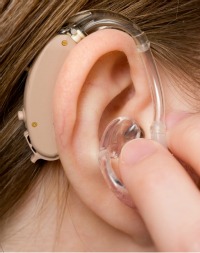
Hearing aids are commonly used to address communication difficulties in people with hearing loss. One goal in fitting hearing aids is to restore audibility to portions of speech that, because of the hearing loss, would otherwise be inaudible.
Benjamin Hornsby, assistant professor of hearing and speech sciences, and colleagues examined how degree of hearing loss and its configuration (the pattern of loss across sound frequencies) impacted benefit from amplified speech. They tested 62 adults with a wide range of high- and low-frequency hearing losses.
In the September/October issue of Ear & Hearing, they report that the configuration of hearing loss affects our ability to use speech information in different frequency regions. They found that extending high-frequency amplification improved, or did not degrade, speech understanding in all cases except for individuals with very steeply sloping losses (good low- but very poor high-frequency hearing). Individuals with flat hearing losses (similar loss at all frequencies) benefited most from extending high-frequency amplification. These findings have implications for hearing aid prescriptive fitting formulas.